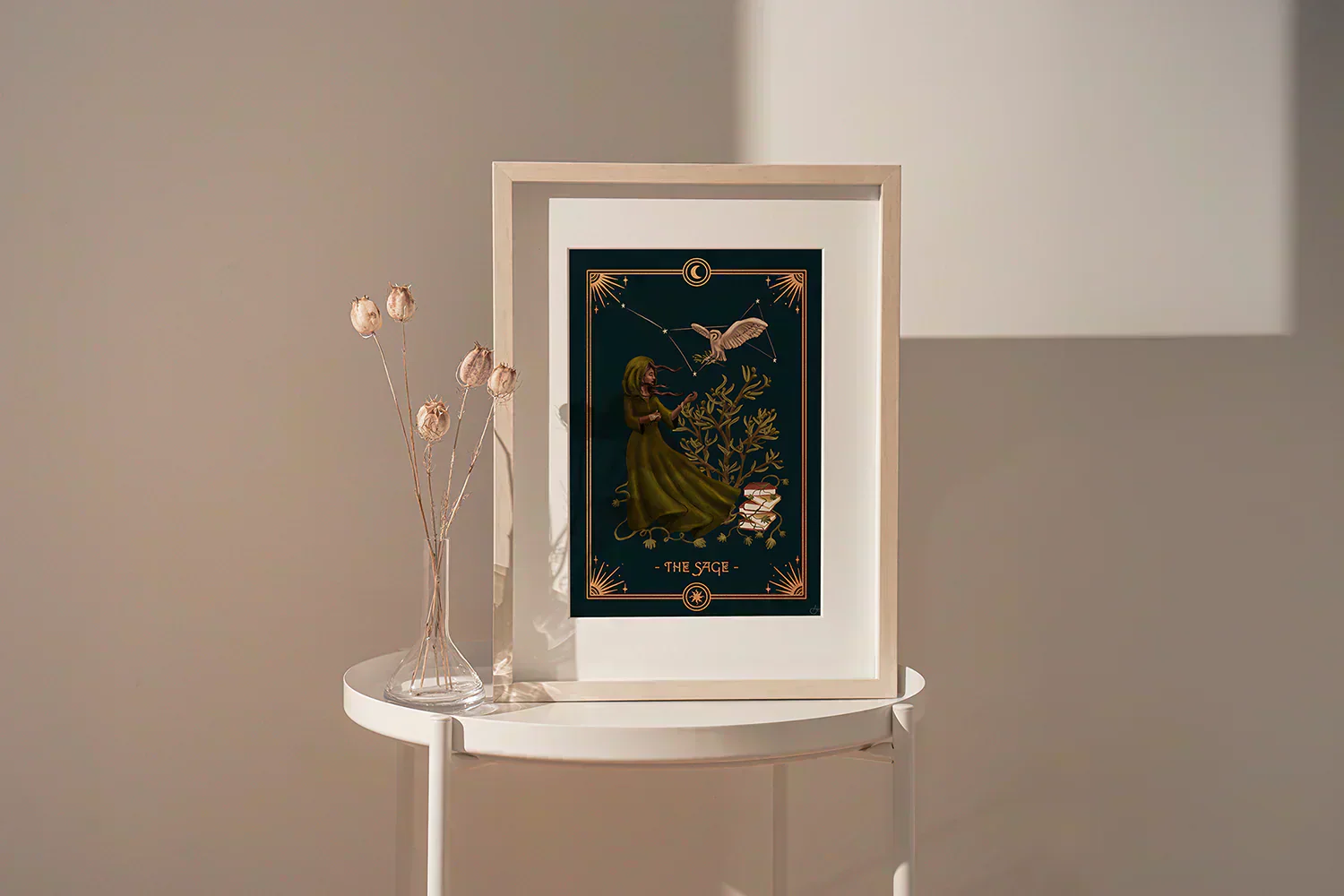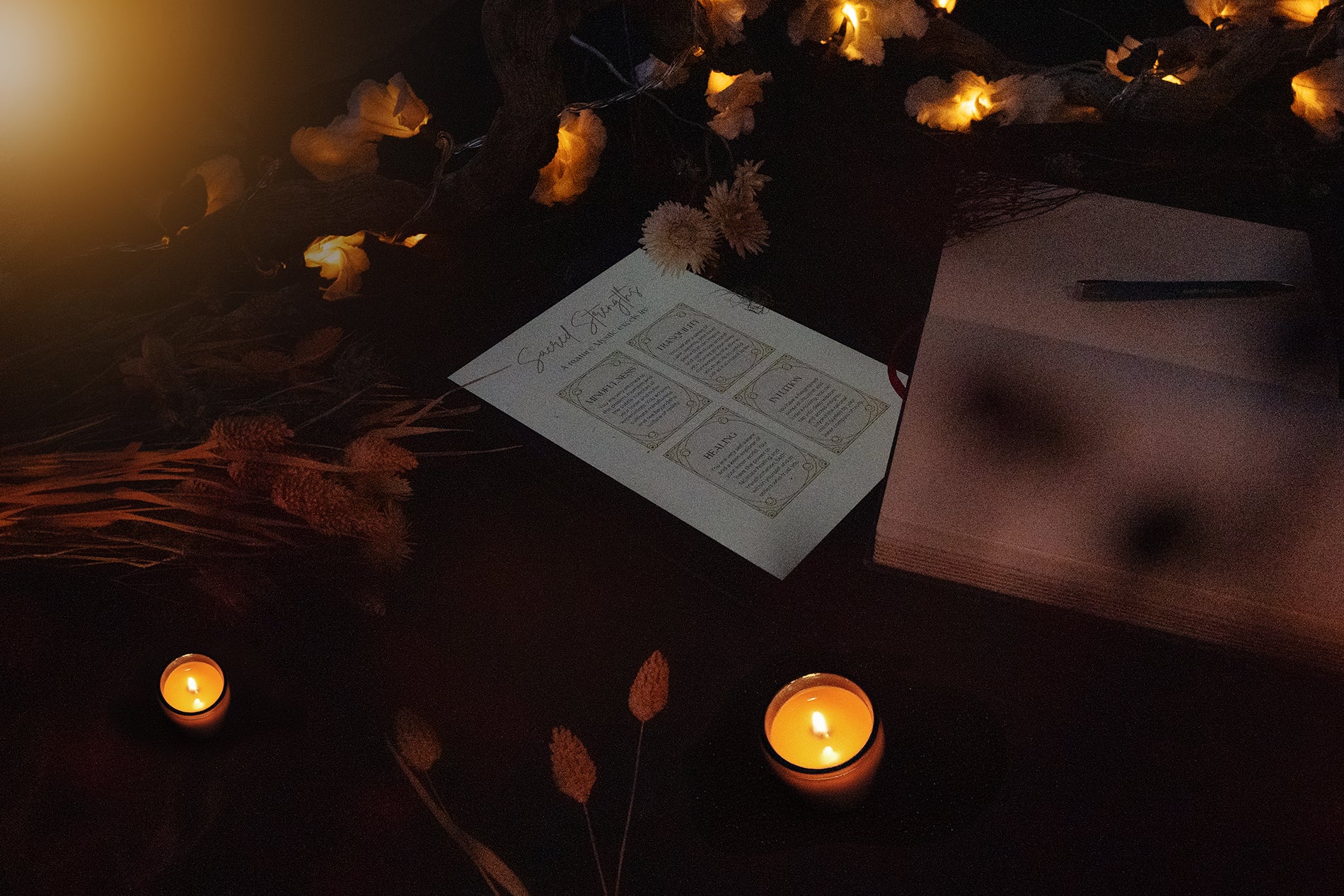
If you’ve ever been the one who double-checks the facts, who says ‘wait, let’s think this through’ before acting, then you have already met the Sage archetype. She is the inner strategist of yours. The part of you that values clarity over chaos. Logic over impulse.
The figure of the wise woman appears again and again in stories and myth. For what is a hero without the one who shows the way? The Sage seeks truth, questions things, and sees patterns others miss.
With her mind as her most trusted companion, the Sage is never done learning. She craves information, which she skillfully turns into insight that guides herself and others. Her gift is discernment: Where others get swept up in emotion, she teaches us how to remain steady instead of reactive and make smart decisions for ourselves.
The Sage archetype's greatest gifts
While women are often said (or expected) to be "emotional", the Sage embodies quite the opposite. She takes great pride in her rational mind and usually decides head first, emotion second. With her way of operating, the Sage may sometimes feel like an outsider, not fulfilling the cultural expectations placed on women – which can leave her feeling more at ease among men than among her female peers.
Her ability to assess with logic and reason allows her to to cut through illusions quickly – you do not fool a Sage easily. Her rationality is paired with excellent foresight. Because she has a knack for observing patterns, she often predicts future outcomes correctly, making her a skilled strategist.
In her social life, the Sage does not care for gossip and drama; she prefers to observe everything with a bit of distance. While some may mistake her for cold, this is just an expression of her profound inner stability.
Curiosity fuels the Sage. She is endlessly hungry for knowledge – she genuinely wants to understand how the world works. Whether through books, travel, study, or deep conversations, she is always collecting insights and weaving them into her worldview. Something that also makes her stand out is her ability to correct her perspective, which most people are reluctant to do. When new information refutes her previous stance, she is quick to update her belief system. The Sage archetype knows that the more you learn, the more you realize how little you know.
In consequence, people naturally turn to the Sage for advice. Unlike impulsive advice-givers, she takes the time to analyze thoroughly and weigh all outcomes before speaking. When she does, her words carry meaning, and others do right in trusting her guidance. She can also hold conflicting perspectives without rushing to judgment, which makes her a strong mediator.

The Sage archetype's shadow
Already Jung knew that Eros (our capacity for emotion) and Logos (our capacity for reason) need to be in balance. The Sage can easily slip into overthinking, analyzing every detail so deeply that she becomes stuck in thought, unable to act. This tendency to prioritize thinking over experiencing can keep her trapped in her head.
The same goes for feeling: Her reliance on the mind can make it hard to open her heart. Vulnerability feels unsafe, so she hides behind her detachment. She may appear as though nothing touches her, but it's often a mask, hiding her discomfort with strong emotions. If she has never actively worked on building emotional intelligence and empathy, the Sage can struggle to recognize or name feelings, both her own and others’.
While avoiding vulnerability might feel "safer", she risks never letting others see her full self. Making meaningful connections that way is hard, and can even lead to social isolation. The Sage may also be out of touch with her body, making it difficult for her to experience sensuality and listen to her body's cues.
Even knowledge, when unbalanced, can create conflict. In shadow, the Sage may become critical or dismissive of those who lead with emotion or just don't "get it" as quickly as she does. She needs to learn that intellect does not make one superior and work on integrating the emotional intelligence she might be missing.
What healing can look like for the Sage:
- reconnecting with the physical body and senses
- balancing head and heart
- finding community and using her wisdom for the greater good
- consciously practicing empathy and compassion
- releasing perfectionism and making peace with "good enough" to move forward
- allowing vulnerability
If you’re ready to integrate this archetype, the guided prompts in the Sage Workbook will walk you through it, helping you explore your own patterns and transform them into strength.
The Sage in Mythology: Athena
Famously associated with the Sage archetype is Athena, the Greek goddess of wisdom, strategic warfare, and handicrafts. Born from her father’s mind after he swallowed her mother Metis (wisdom itself), Athena was an incarnation of intellect, born a natural weapon. No diapers for her – she arrived in full armor, ready to think and fight.
Athena was cunning, deliberate, always three steps ahead. She served as Odysseus’ divine guide and protector, and guided the Achaeans in warfare with strategic cleverness. Though protective, her wisdom could also be merciless. In later myths, those who rivaled or disrespected her were punished brutally. With the same determination, she was fiercely protective of her virginity, never letting herself be tied down by man or child. She belonged to herself and herself only.
Unlike Artemis (Huntress archetype), she keeps little company with women, which reflects how she moves with ease and authority in male-dominated realms.
When Athena and Poseidon battled for Athen's patronage, Poseidon struck the ground with his trident, bringing forth a salt spring. Athena offered the olive tree, a symbol of nourishment and lasting resources. The people judged her gift more useful, and the city took her name: Athens.
Athena’s myth reveals light and dark: pure intellect, without compassion, can lead to destruction – yet when reason is joined with wisdom, it creates solutions that endure, like her olive tree that still stands as a symbol of peace and prosperity.
List of Sage archetype examples
In mythology: Athena (Greek goddess of wisdom & warfare), Minerva (Roman equivalent), Cailleach (ancient Crone goddess of winter, weather, and wisdom), Thoth (Egyptian goddess of wisdom, magic & the moon), Saraswati (Hindu goddess of knowledge & learning), Grandmother Spider (Native American wisdom keeper)
Real-life examples: Emma Watson, Marie Curie, Simone de Beauvoir, Angela Merkel, Ruth Bader Ginsburg, Chimamanda Ngozi Adichie, Tilda Swinton, Susan Sontag, Margaret Atwood
In fiction: Hermione Granger (Harry Potter), Elizabeth Harmon (The Queen's Gambit), Belle (Beauty & the Beast), Minerva McGonagall (Harry Potter), Dana Skully (The X-Files), Moiraine Damodred (The Wheel of Time), Miss Marple (Agatha Christie), Annalise Keating (How to Get Away With Murder)
Psychological & developmental perspective
The Sage has a very different rhythm from the Maiden, Mother, or Lover. The Sage appears when we learn to step outside the pull of ego and drama, meeting life with calm reason instead. As we all know, wisdom takes time, so this archetype doesn’t usually dominate early life (even though there are always exceptions and some people simply gravitate towards the Sage naturally). Generally, the Sage is strongly linked to midlife and later life, what makes it in some ways similar to the Crone archetype, even though the latter is characterized more by lived experience than intellectual knowing.
In relationships
The Sage isn't here to mess around in love; she is looking for someone to grow with, who can keep up with and see eye to eye with her. With her, conversations often run deep and she shines as a a steady presence when life gets turbulent. In the shadow, she may retreat into analysis when vulnerability is called for, leaving her partner feeling unseen.
Career
As you can surely guess, the Sage feels at home in strategy and enjoys working towards complex, long-term goals. She shines in any path that rewards intellect and problem-solving; examples would be research, science, law, consulting or leadership roles that require big-picture thinking.
Personal growth
The Sage archetype can help you to:
- make well-informed, rational decisions
- see beyond limiting beliefs and attain self-mastery
- pursue academic or intellectual goals
- develop critical thinking and problem-solving skills
- detach yourself from hindering emotions
- increase discipline and assertiveness
- solve moral dilemmas and provide wise counsel to others
- make meaningful contributions to society
The Sage is here to teach us healthy detachment, perspective, stability and guidance when it is needed the most. When balanced with emotional capacity, e.g. by integrating more relationship-oriented archetypes, she is a powerhouse that cannot be stopped.
If you feel called to connect more deeply with the Sage, you might enjoy the Feminine Archetype Workbooks. I created them as an integrative practice, full of guided prompts and reflections, so you can embody your wisdom more fully.
In a world that often disempowers women, do not hesitate to trust your inner wise woman. Speak your truth, and good things will follow. ✨

Continue the journey
Grow with the archetype workbooks
The Feminine Archetype Workbooks are gentle companions for self-reflection and personal growth. Each one offers prompts, insights, and exercises to help you become the woman you were always meant to be. If you’re curious to explore what these archetypes might awaken in you, let the workbooks guide you into deeper alignment with your most authentic self.
Quick navigation